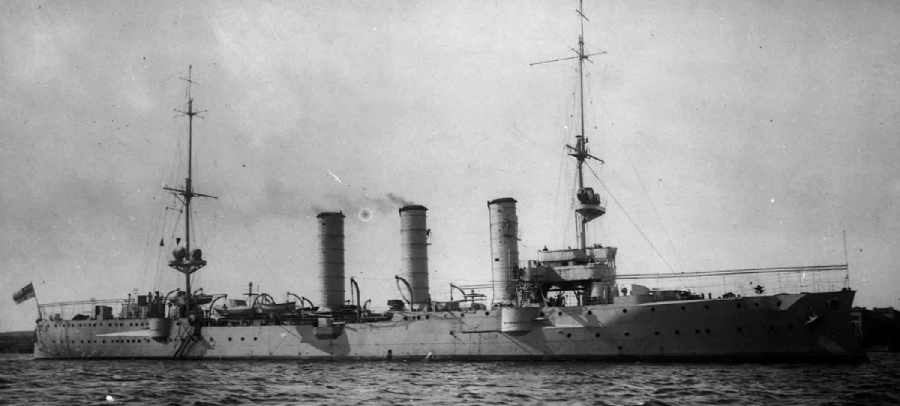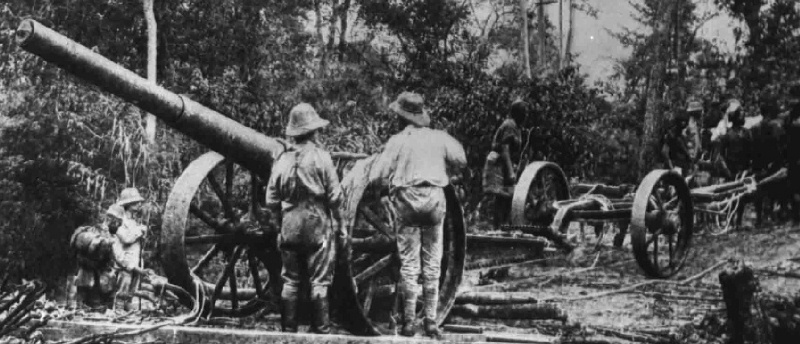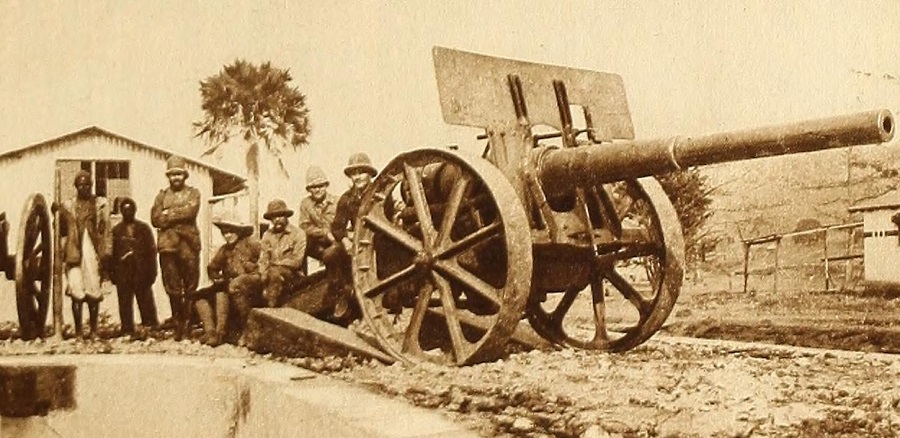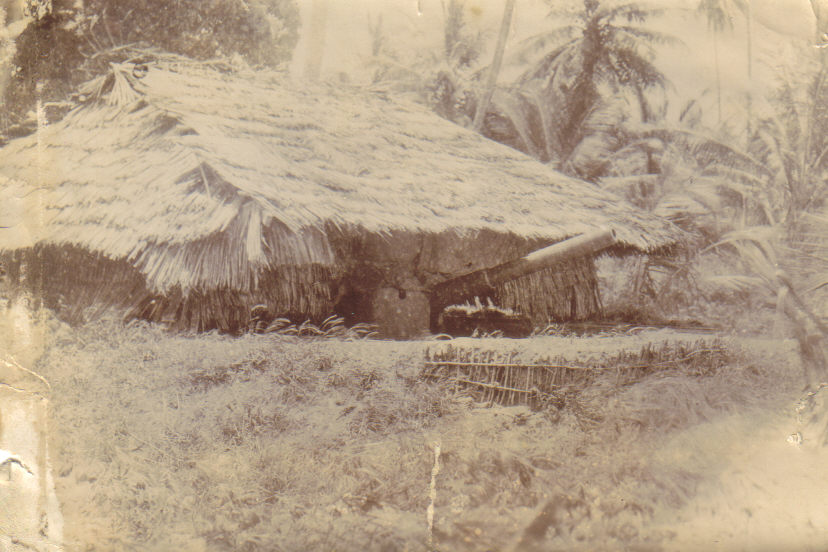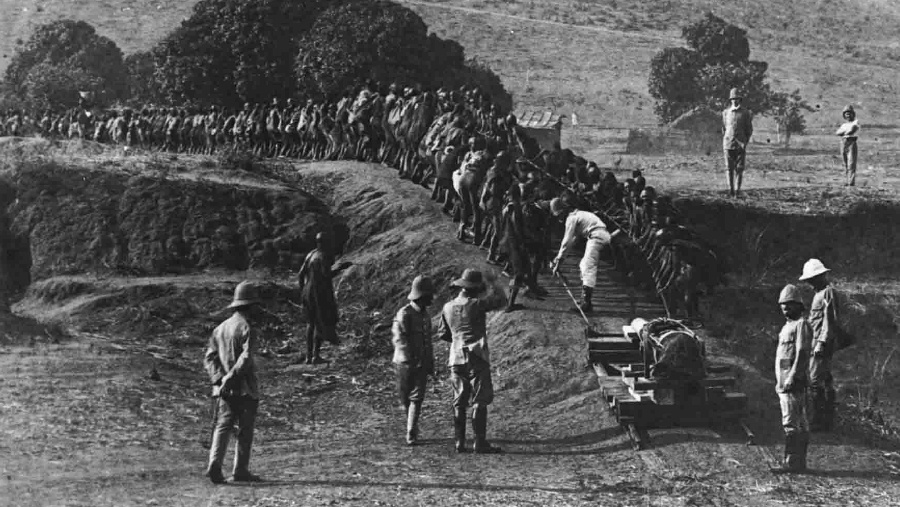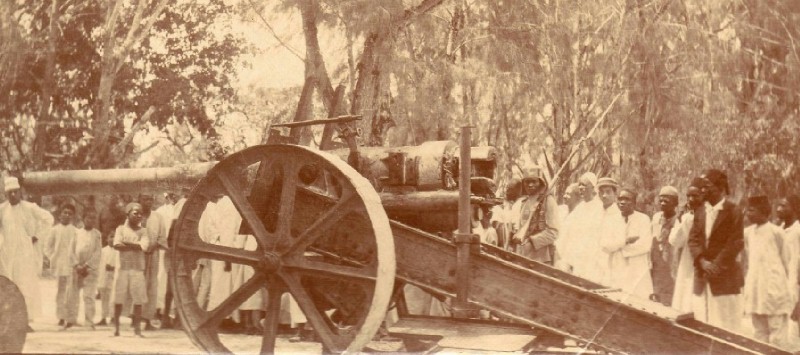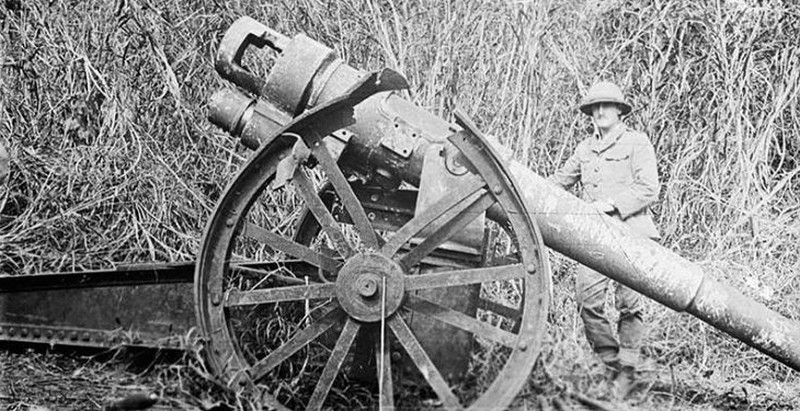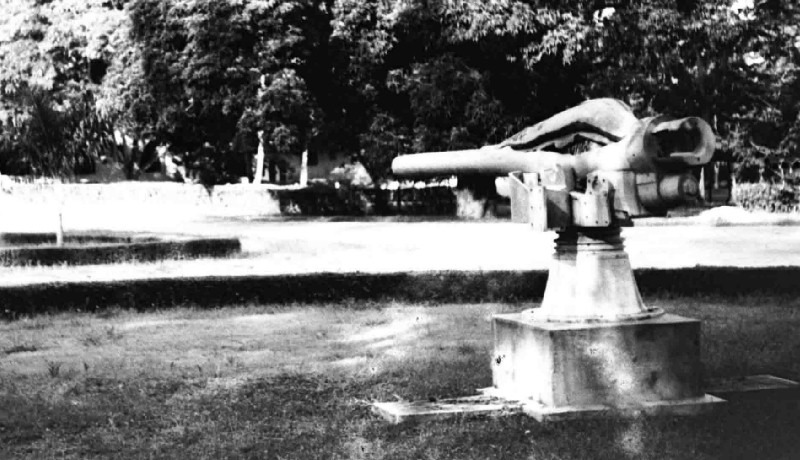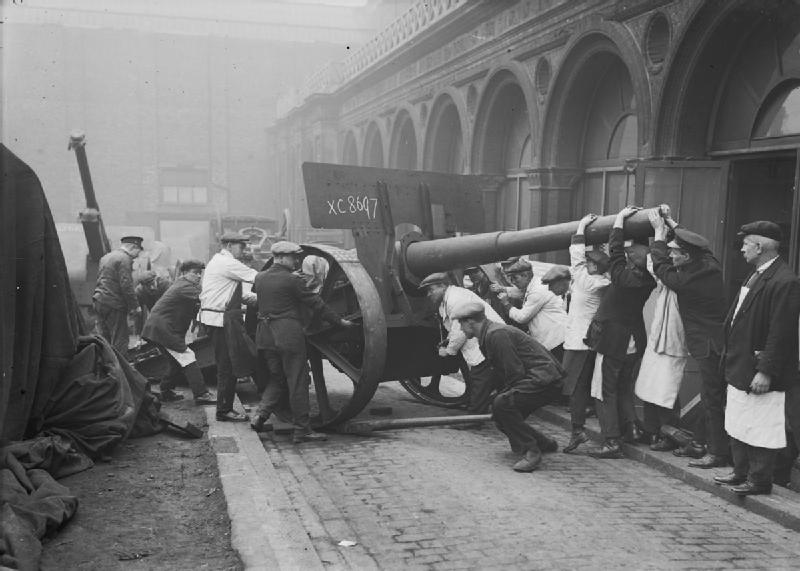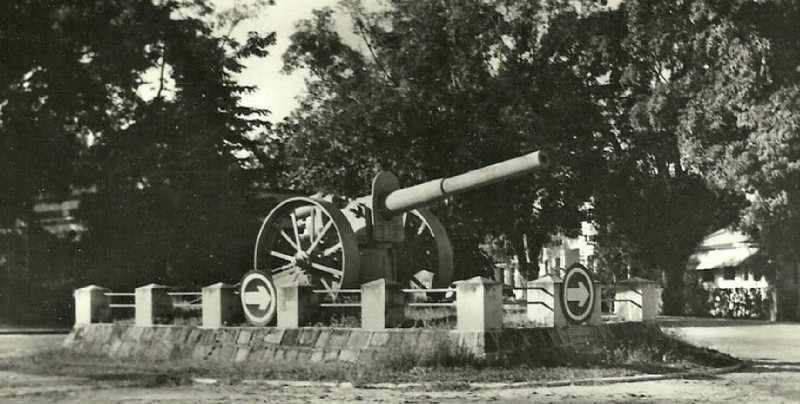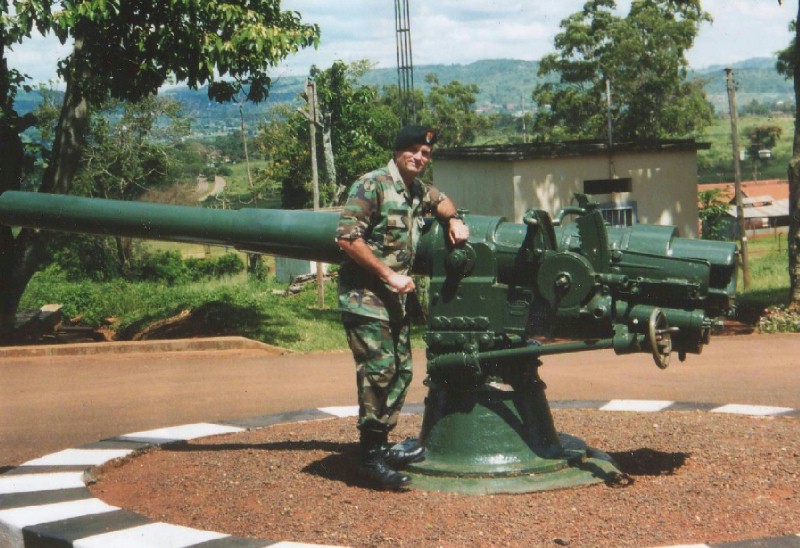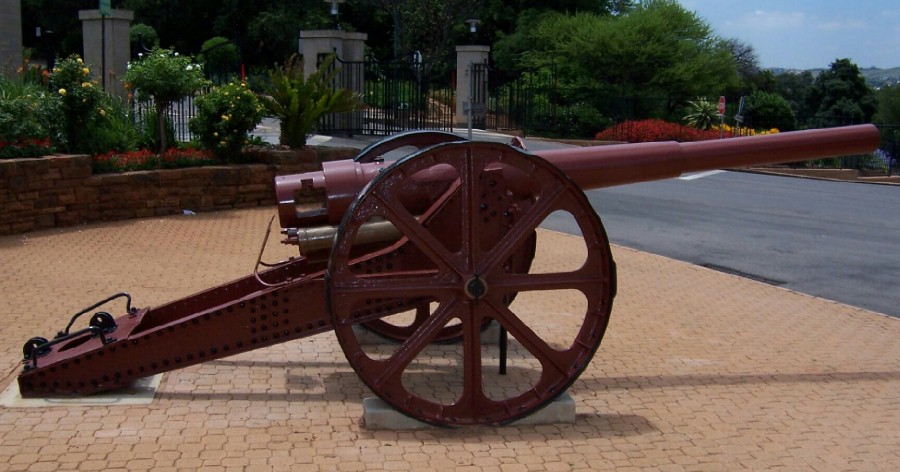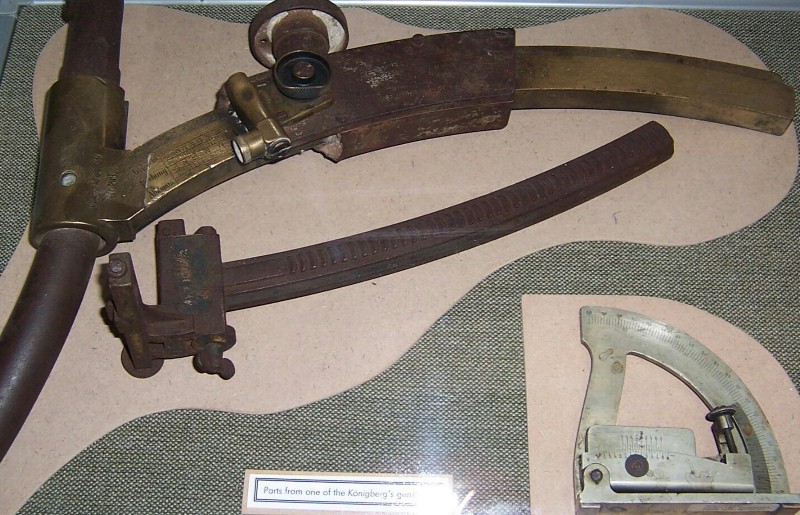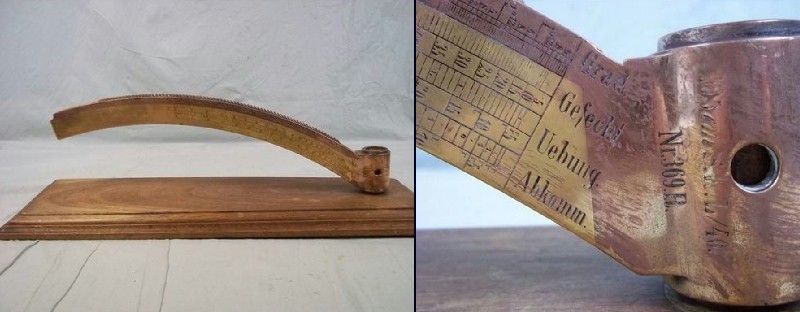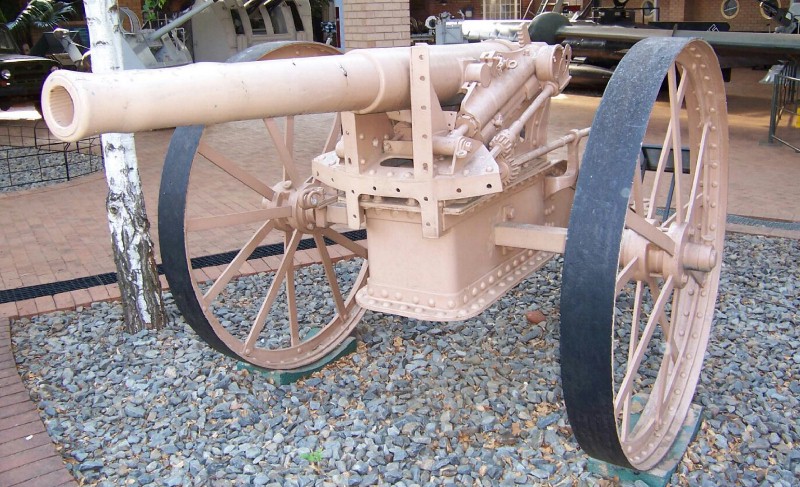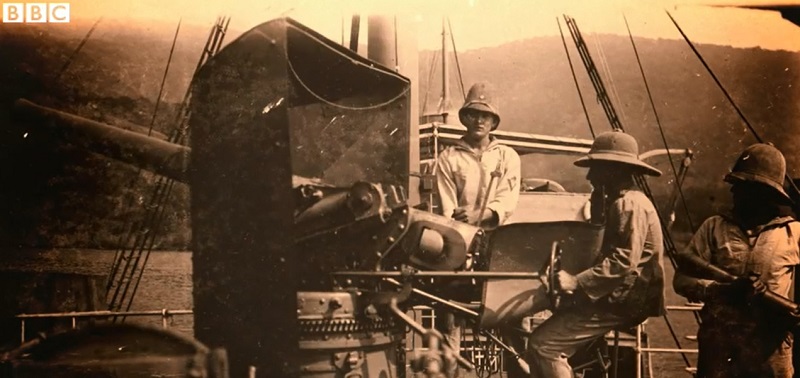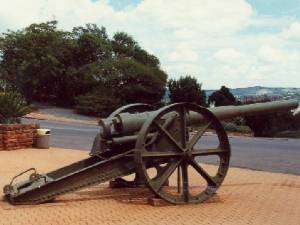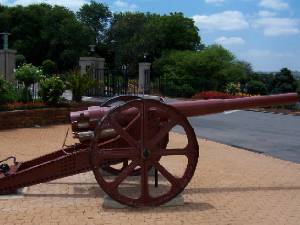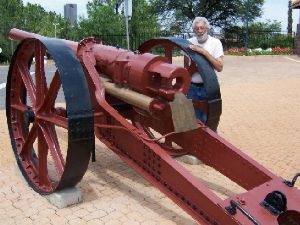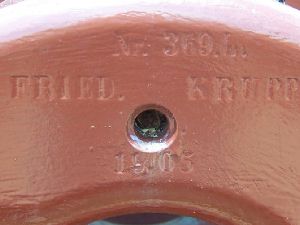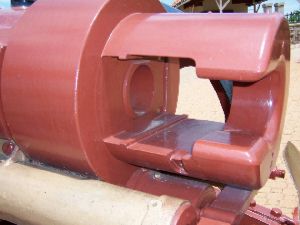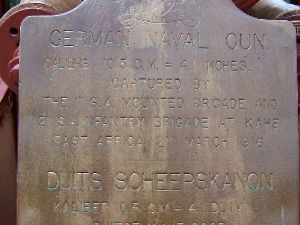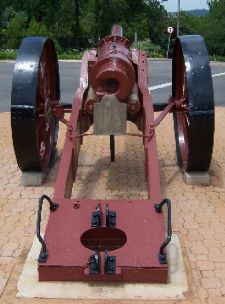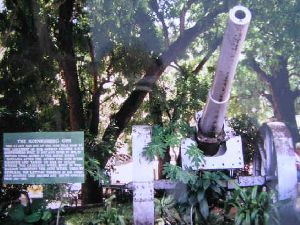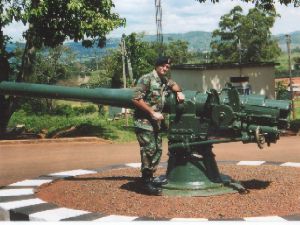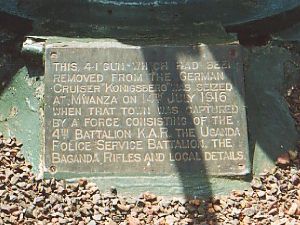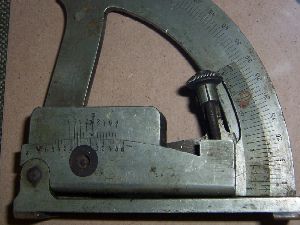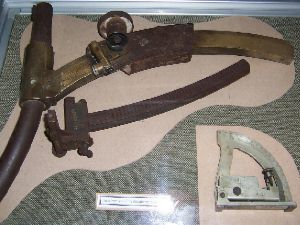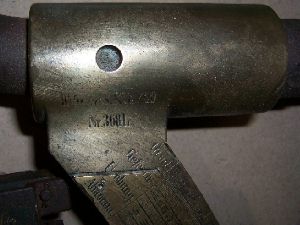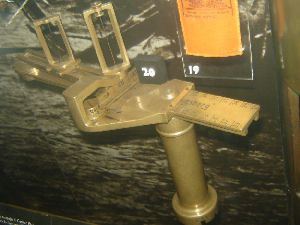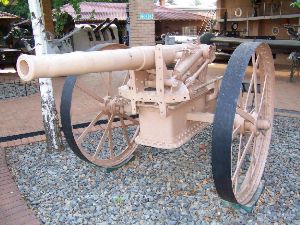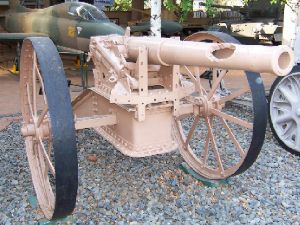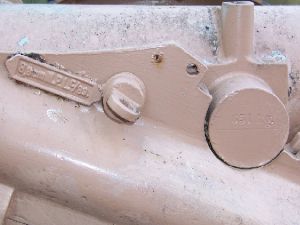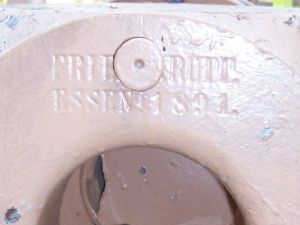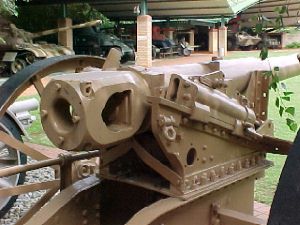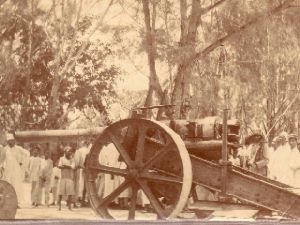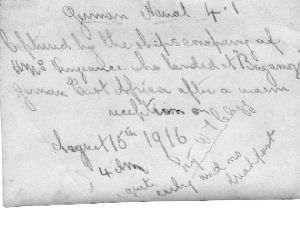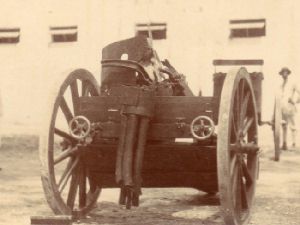The story of the Königsberg is a fascinating
one, and that of her main armament even more so. Not only did these guns serve
on the ship in the warm waters of the Indian Ocean, but also on the dusty plains
and the rain forests of East Africa. Today one of these remarkable guns rests at
the western approach of the Union Buildings in Pretoria.
SMS Königsberg was the first of a new class
of fast well armed Town Class Cruisers (Kleiner Kreuzen) displacing 3,500 tons,
built for the German Navy (Kaiserliche Marine) at the turn of the 20th century.
Launched in 1905 she was a sleek, three funnelled predator, carrying a main
armament of ten 10,5 cm quick firing guns (German: 10,5 cm Seekanone or 10,5 cm
SK). She initially served with the Baltic Fleet where she also acted as escort
to the German Kaiser’s Royal Yacht Hohenzollern before being laid up at Kiel in
1912. In late 1913 the German East Africa government requested a suitable
replacement for their elderly sail and steam corvette, S.M.S. Geier then on
station. Four months later on 25 April 1914 a re-commissioned Königsberg
commanded by Fregatten Kapitan Max Looff left the Kiel naval base for East
Africa to reaffirm German naval power in the Indian Ocean. After arriving at Dar
es Salaam on 6 June, Königsberg, played host to innumerable German and African
visitors in ports along the colony’s coastline. Little did her crew realise that
East Africa was to be, for most of them, home and headquarters for what remained
of their short lives.
On 28 June 1914, the Archduke of Austria was
assassinated in Sarajevo, and as the political situation in Europe slid towards
open war, the Germans in East Africa began to weigh their options. Looff's
immediate goal was to ensure his ship was at sea if war came. The British were
aware of the new threat on the coast, and in case of war would blockade Dar es
Salaam. As the latter part of July passed, Königsberg completed a series of
gunnery training exercises and steamed back into harbour for an overhaul to
wartime readiness. All wood furnishings were removed, lacquered panelling
stripped away and coal and supplies poured into every empty space. By July 30,
all was nearly ready and Looff spent time ashore coordinating his plans with the
Colonial Army, commanded by the famous General Paul von Lettow-Vorbeck. German
freighters in the area had been ordered to bring in their spare coal, and two
were in harbour at that stage. One of these, the 2,500 ton Somali, was pressed
into service as Königsberg's seagoing supply depot. On July 31, the steamer
Tabora arrived with news that the British Cape Squadron, based at Simonstown,
South Africa, with their three cruisers under Vice Admiral King-Hall was due at
Zanzibar the next day. There was now no more time for planning if Königsberg was
to avoid being trapped in the harbour. By 4:30 that afternoon she cast off and
made her way out into the Indian Ocean.
The Königsberg was ten miles out to sea and
evening was falling when the officer in the foremast called down - three ships
approaching! The Cape Squadron had arrived, only to see their objective steaming
out to sea. All three British cruisers; H.M.S. Hyacinth, Pegasus and Astraea
converged on the Königsberg and took up station around her - Astraea to port,
Hyacinth astern and Pegasus ahead. If word of war came then Königsberg could
hardly have been in a worse situation. Looff considered his options and while
the gunners would have been at the ready, he ordered his chief engineer to fire
up all the boilers without making extra smoke. After 45 minutes the Königsberg
had steam for her full speed of 24 knots and now only had to wait for whatever
chance might come to use it to escape. Until such opportunity arrived, she
cruised along at 10 knots, giving no sign of other plans. Not long after, a
squall suddenly blew in from the southwest, and without warning Königsberg was
blanketed by driving warm rain, all her "escorts" disappearing from view.
Instantly orders went out and the cruiser made a 180 degree turn, churning a
great knuckle of water behind her as she sped back on a reciprocal course. As
she cleared the squall, Königsberg passed the Hyacinth, already making heavy
smoke as she vainly tried to bring up steam for full speed. Looff turned south
for an hour and then headed out to sea at full speed for the rest of the night,
consuming a large quantity of valuable coal in the process. King-Hall was left
to his own fury at letting the German cruiser escape from under his nose, while
Looff was left to wait for war, in a cruiser already looking for coal to top up
her bunkers.
Four days later, on August 4, the Königsberg
was making her way through heavy seas off Cape Guardafui when she received a
wireless code message declaring that Germany was now at war with England, France
and Russia. This meant that in the vast open space of the Indian Ocean, she was
now alone and hunted by a numerically superior foe. But she herself was designed
to hunt, and Looff was out for prey. After contacting as many German merchant
ships as possible, to both notify them of war and ask for coal, Königsberg
headed for the main shipping channel from the Red Sea to India which ran just
north of the Horn of Africa. Within several hours of daylight she encountered
three German steamers, the last of whom tried to evade the cruiser thinking her
to be British. This short pursuit wasted more coal, and none of the steamers had
any to spare. Finally, after passing a Japanese freighter, Königsberg drew her
first blood when she came upon the British steamer City of Winchester. The
steamer rang up all stop and prepared a welcoming party for the British cruiser
she thought Königsberg to be. Only when the German officer arrived on deck did
the Winchester's crew realize their dreadful mistake. This, the first British
merchant ship to be taken by a German man-of-war, was also carrying most of the
1914 Ceylon tea crop, making it a double blow for the British.
After scuttling the City of Winchester at
Hallaniya Island off the Oman coast, Königsberg's coal situation was even more
of a concern and she turned back to the main shipping lane but found nothing.
The British had reacted swiftly to the disappearance of the City of Winchester
and diverted all ships away from the area. Also, the Japanese freighter had
recognized the Königsberg for what she was and radioed British authorities.
While the upheaval caused by his cruiser might have given Looff some comfort,
his concerns were increasingly focused on finding more coal and fresh water.
Fortunately for him, the second rendezvous with the Somali at Ras Hafun on the
Somaliland coast went mostly as planned, and by August 24 the Königsberg was
underway again with full bunkers.
Cut off from radio contact with Dar-es-Salaam
(the radio station at the capital being destroyed during a British naval
shelling of the city), Looff headed for Madagascar where he hoped to intercept
French shipping. Early on the morning of August 29 the German cruiser steamed
into the bay at Majunga, only to find a Red Cross station and no ships. The
entire area had been evacuated. Again, the locals believed the Königsberg to be
British, and only when she was steaming back out of the bay without anchoring
did the local radio send out alerts that the Germans were in their harbour.
By now Königsberg's coal supply was down to
250 tons and again she met the Somali, this time at Aldabra Island, but the
coaling effort was called off due to rough seas. Coal was not Looff’s only worry
as the ship also required some work on her engines. With the situation becoming
critical, it was decided that both ships would head for the Rufiji River Delta.
The delta had recently been charted by the crew of the survey ship Möwe who
discovered the river, formerly considered unnavigable, actually had several deep
channels. On the morning of 3 September Königsberg passed the bar at the mouth
of the Rufiji River and steamed quietly up the Simba-Uranga channel to Salale.
Once the German authorities at the nearby
customs station recovered from their shock at the cruiser’s unexpected arrival
they quickly advised Dar es Salaam of the cruisers whereabouts and that she
required coal and supplies. Looff was also able to gather the latest news on
world and local events, the most important of which came on September 19. A
coast watcher reported he had seen a British cruiser steam into Zanzibar
Harbour. The news was relayed to Looff who having replenished his bunkers
decided to head to Zanzibar, and destroy the lone British cruiser. Judging by
the watcher's description of the British ship, it must be the Pegasus or the
Astraea. In reality, it was Pegasus which had returned to Zanzibar for
maintenance.
A Third Class cruiser of the Pelorus class,
Pegasus had been launched in 1897 and displaced 2,135 tons, while her 4 inch
guns were no match for the Krupp 4 inch guns on Königsberg. Because of a
combination of boiler troubles common to the class, and the fact that she had
been burning sulphurous Natal coal, she to put in at Zanzibar for desperately
needed repairs. It was considered a safe move by British authorities, convinced
that Königsberg was no longer in East African waters. They were wrong.
Königsberg sailed that afternoon and by late
evening, was steaming for Zanzibar at her economical speed of 10 knots. Higher
speeds caused sparks to shoot from her funnels, something they wished to avoid
that night. By four o'clock in the morning, they were off the southern tip of
Zanzibar and passing between the reefs. The tug Helmuth on guard duty was
disabled by a shell. As they approached the village of Mbweni they could see
Pegasus at anchor off the Eastern Telegraph Company offices at Shangani Point..
At a range of five miles, Königsberg ran up her battle flags and opened fire
with her five port guns. Within eight minutes Pegasus was out gunned and on fire
with heavy casualties. Her captain, Commander John Ingles struck the colours and
surrendered. The white flag was seen by Looff who ordered a cease fire and
departed. The Pegasus had been hit numerous times and the ship was slowly
sinking. Despite efforts to beach the ship, Pegasus sank at two thirty that
afternoon with a loss of 38 killed and 55 wounded. .
Leaving Zanzibar, Königsberg suffered a
broken cross head on one engine and together with steam leaks caused by the
bombardment, Looff had little alternative but to postpone his plan for a return
trip round the Cape to Germany, while he effected repairs in the Rufiji. Only
the railway machine shops at Dar es Salaam would be able to machine the parts
needed and so, twenty-four hours after her departure, Königsberg was back in the
delta, the only safe place on the coast for her to lay up. The delta was
bisected by numerous channels, and the Germans were the only ones who knew that
several of them were navigable. In case of emergencies, Königsberg would have an
escape route. In the meantime, the engine parts were sent overland to
Dar-es-Salaam by ox cart. To complete her disappearance Looff had the top masts
dropped and camouflaged the remainder as trees, while some of the ship’s light
weapons were moved ashore to keep possible British landing parties at bay. Later
they were joined by forces from the land army who garrisoned the local islands,
creating a safe zone around the raider. For now, she would be safe.
Looff was unaware of several events
developing elsewhere. Two days after his attack at Zanzibar, the German cruiser
Emden shelled the port of Madras in India, causing huge panic and setting some
fuel tanks ablaze. This double blow to British pride was not to be stood for,
not to mention the strangling effect these German actions had on shipping. The
six inch gun cruiser H.M.S. Chatham was ordered to East Africa from the Red Sea
to seek and destroy Königsberg. The first break for the British occurred when
Chatham searched the German liner Präsident and discovered an order for
shipments of coal to be delivered to the Rufiji Delta and the cruiser H.M.S.
Weymouth intercepted the German tug Adjutant with a chart showing Salale. Soon,
reports began trickling from locals in the Rufiji area of a German ship moored
there and on the afternoon of October 20, Chatham anchored near the Kiomboni
branch of the delta to send a landing party ashore. Fortunately for them, it was
at a place where there were as yet no German fortifications. Chatham closed the
delta mouth and spotted the Somali masts rising above the green canopy of the
river delta's forests, her cover was blown.
On the morning of November 30, Chatham zeroed
in on what they now knew to be the Somali’s masts and fired. Somali was hit
several times and soon began to burn and Looff moved Königsberg further up the
delta, out of range having suffered no damage during the day. Although the
mechanical problems had been repaired, the situation was now grim, Königsberg's
hiding place was blocked by three large, fast modern cruisers, and she lacked
coal for a high speed run. Captain Drury-Lowe on board the Chatham had been
given explicit orders to destroy the Königsberg at all costs. This was to be the
start of an eight month long impasse, during which Königsberg was unable to
escape from the delta, while the British were unable to get close enough to
bombard her. More entrenchments were dug throughout the delta, creating a
fortified zone which no British land force could hope to secure. On the British
side, there were several attempts to bring aircraft in for reconnaissance and
bombardment. The former worked occasionally, sometimes causing alarm when they
reported Königsberg with steam up and ready to run for the open ocean. The
latter never had a chance, as the aircraft were so unreliable that their main
goal was to stay in the air, not dropping bombs! After a few encounters with
these snooping aircraft, Looff arrayed a series of light cannon and machine gun
positions as an anti-aircraft defence. These proved effective and brought down
at least one of the British planes.
On New Years Day a message was sent to Looff
from H.M.S. Fox, "We wish you a Happy New Year and hope to see you soon."
Looff replied, "Thanks, same to you, if you wish to
see me, I am always at home."
In April 1915, the Kronborg, a "Hilfschiff"
(or blockade runner) bearing supplies for Königsberg and the land army, arrived
in the Indian Ocean after a long voyage from Germany. Disguised as a Danish
freighter, she was carrying 1,600 tons of high grade Ruhr coal for the cruiser,
as well as hundreds of rounds of ammunition for the 10.5 cm guns, machine tools,
cutting torches, clothing, fresh and canned provisions and a variety of other
supplies. She also carried over a million rounds of small arms ammunition,
rifles and machine guns for the land army. The British however, knew of her
arrival, and thanks to diligent eavesdropping on German radio transmissions,
they had discovered her purpose. The ship reached Manza Bay near Tanga, when the
British cruiser Hyacinth appeared from the south. The captain of the Kronborg
brought his ship into the bay at full speed, and ran it aground before setting
fire to the deck cargo. The Hyacinth attempted to put the fire out but retreated
and shelled the ship. The Germans promptly sent messages in the clear announcing
the destruction of the ship, and that they had mined the bay. This last bit of
news had the effect of keeping the British away long enough to allow the salvage
of the cargo in her submerged holds. By the time the British returned a few
weeks later, they discovered to their dismay the Germans had salvaged everything
except the coal. The logistics of moving the coal to the Rufiji would have been
impossible with the facilities available.
The loss of the coal meant that Looff and the
Königsberg would be confined to the delta. By this time the ship was now burning
mangrove wood cut from the surrounding swamp by local labour to maintain power.
Their fear was that a second Hilfschiff would get to the Königsberg, allowing
her to head back into the Indian Ocean, but the second ship Marie did not arrive
until the following year. What he did not know, was that the British had begun
systematically charting the delta and the complex web of defences with the help
of a South African hunter, Peter Pretorious. The British Admiralty also
dispatched two ex Brazilian Navy monitors, the Mersey and Severn, to East Africa
where they arrived in June 1915 after a long and difficult tow from the
Mediterranean. By this time the crew of the Königsberg had been reduced by a
third in order to supplement the land army after convincing the navy that the
crew were more valuable fighting on land, instead of resting idly in the delta.
The British were unaware of these developments, but they knew Königsberg was
awaiting a second Hilfschiff.
On July 6, 1915 the two monitors finally
executed the operation carefully planned and rehearsed over several weeks.
Severn and Mersey, supported by warships at the delta mouth, headed up the
Kikunja branch of the delta. Looff was soon aware of their arrival through his
network of lookouts. At 06:23 the monitors opened fire using a spotter plane to
locate the fall of shell. Königsberg's return fire was accurate, due to the
network of lookouts linked by telephone who passed the monitors position to the
cruiser. The British fire was inaccurate due in part to the signalling system
used between the planes and monitors. At 07:40, a shell from Königsberg hit the
Mersey's forward six inch gun, knocking it out and almost blowing up the ship.
She was saved only by the heroic action of crewmen who threw a burning shell
into the river. Near misses continued to shower the monitors with shrapnel, and
after scoring only four hits on the Königsberg, the monitors retired on the
falling tide. Immediately after Severn moved off, five shells from the cruiser’s
guns landed right where she had been moored. Had they hit her, this perfect
group of shells would have wrecked or sunk the small monitor. The British
counted their luck, they had fired 635 six inch shells and scored four
inconclusive hits on the Königsberg. The Mersey had lost one of her two main
guns and Severn missed being blown out of the water by what her captain called
blind luck.
For four days all was quiet, but early on
Sunday, July 11, the aircraft began circling Königsberg, announcing the renewal
of a second attack. By 10:40 the monitors were in the entrance to the river and
by 11:30 the Königsberg had begun firing, hitting the Mersey with two shells,
putting the rear main gun out of action. With the Mersey now completely
incapable of returning fire, the Königsberg switched attention to Severn, who
held her fire under the rain of shells until the second spotter plane arrived at
12:30. The carefully rehearsed signal system between ship and plane worked
perfectly the second time and Königsberg was severely damaged with a number of
casualties and damaged guns. The loss of the telegraph line to the ship from the
lookout posts meant she was firing blind and unable to keep up the same rate of
fire. Within a short time, a hit from Severn ignited ammunition in the
Königsberg's after magazine, causing an explosion and a fire. Other hits killed
a number of the crew and damaged the bridge, injuring Looff and all but one man
present. Finally, one of the two remaining guns fired its last round of shrapnel
ammunition at the spotter plane, bringing it down in the river. As shells
continued to rain down, First Officer Koch rigged a torpedo head as a scuttling
charge and at two o'clock that afternoon Königsberg heaved slightly as the
torpedo detonated. The blast tore open the cruiser's hull and she heeled to
port, sinking into the mud with her upper works just above the waterline. She
had occupied the Royal Navy for nearly a year tying up twenty ships and ten
aircraft and consuming nearly forty thousand tons of coal. Looff signalled
Berlin: “Königsberg is destroyed but not conquered.”
These were prophetic words as the Königsberg,
although doomed as a fighting ship, still had plenty of fight left in her. From
Dar-es-Salaam the order went out to salvage everything of use from the ship.
Especially her main guns which were used by the German land forces to supplement
their field artillery. The heavy guns were recovered and dragged on carts
through the bush to the capital. There they were cleaned and carriages
constructed from boiler plate at the railway workshops. Some guns were intended
for fixed defences and received no carriages. Around 1,500 shells were salvaged
from the Königsberg and the Kronberg and shared out between the ten guns.
From Dar-es-Salaam, the guns were despatched
to various corners of the colony where they began their second career. They were
skilfully operated by sailors from the Königsberg, now facing the African
jungles instead of the open seas. One was mounted on the Goetzen, the largest
steamer on Lake Tanganyika but later removed for use on land. The refurbished
guns gave good service to the German ground forces, being much valued for heavy
artillery support. Their shortcomings were that they were heavy and not very
mobile, while their armour piercing shells were not intended for land use, and
often buried themselves deep in the ground before exploding. South African
troops fighting at Kondoa Irangi in July 1916, noted their satisfaction with
this state of affairs. There was however some casualties to these guns and their
persistent shelling were trying to the nerves.
As the war rolled on over East Africa, the
Germans were forced to abandon or destroy these heavy guns. Their intrinsic lack
of mobility became a liability as the Schutztruppen and their African Askari
troops moved into a war of movement in the vast regions of Southern Tanzania.
The Königsberg guns were abandoned or captured as follows :
1 at Kahe, March 1916
1 at Mwanza, July 1916
1 at Kigoma, July 1916
1 at Bagamoyo, August 1916
1 at Kondoa Irangi, August 1916
1 at Tabora, September 1916
1 at Kahima, September 1916
1 at Mahiwa, Octobery 1917
1 at Massasi, October 1917.
1 at Kibata, October 1917
Most of the guns were abandoned or destroyed
after they ran out of ammunition by their crews to prevent them from falling
into enemy hands. After the end of hostilities the captured Königsberg guns were
distributed as trophies and the following locations are known :
1 to Pretoria, South Africa
1 to Mombasa, Kenya
1 to Dar-es-Salaam, Tanzania
1 to Kampala, Uganda
1 to Leopoldville in the then Belgian Congo
1 to Stanleyville in the then Belgian Congo
Of the Königsberg's original crew of 350 men,
only 15, including Captain Looff, survived the war to return to Germany.
Today only the two guns in Pretoria and Mombasa are known to exist, both are
mounted on similar heavy wheeled field mountings, possibly being those captured
in a better condition (*since this article was written a third gun has been
rediscovered, seen above in Jinja, Uganda). Other items including parts of a gun
and a sighting mechanism are preserved at the South African National Museum of
Military History in Saxonwold, Johannesburg. In the Imperial War Museum, London
is the ships steam whistle and the Inclinometer is displayed at the Fleet Air
Arm Museum at Yeovilton. A few shell cases are also exist in many parts of the
world.
Inspection of the gun located in the grounds
of the Union Buildings in Pretoria, revealed that it is inscribed with the
serial number 369 as well as “FRIED KRUPP, ESSEN”, identifying it as a gun made
by this famous German firm. A bronze plaque attached to the carriage states that
it is the gun captured at Kahe, but this can not be as the Kahe gun was fitted
on a wooden mounting, not a wheeled carriage and was found blown up by the
Germans before they abandoned it. The gun’s naval origins are easily
discernable. The long barrel and heavy cradle type recoil system were designed
for shipboard use. The gun is missing its breech block pointing to the
conclusion that it was abandoned by the Germans once it had used all the
ammunition available. A strong sheet metal carriage supports the gun, but a
closer look reveals the carriage to be very utilitarian in nature. When mounted
on a cruiser the gun had a range of 12,000 metres. The shell weighed 17.4 kg and
the gun muzzle velocity was 600 - 650 m/s. On land the gun would have weighed
around 4,000 kg. At one time the gun was painted a dark green colour but has
been since repainted in maroon. The original colour scheme would probably have
been the same as on the cruiser, i.e. a light sea grey, but it is possible that
it was re-painted to camouflage it during its service on land. Clearly this was
a powerful and unique gun, and one which ought to be preserved not only as a
reminder of the Königsberg’s adventures, but also of South Africa's contribution
to the First World War.
Two sidelights on this story should also be
mentioned. Firstly the Königsberg also carried two smaller 8,8 cm guns (German:
8,8 cm Seekanone L/30) in her hold, probably to equip and transform a merchant
vessel into an armed merchant cruiser. These guns were also used on land and
one, captured in September 1916, is currently on display at the South African
National Museum of Military History.
Secondly, if we cast our minds back to the
Königsberg's most famous victim, the British cruiser H.M.S. Pegasus, then there
is another twist in the tale. Six of the eight guns on Pegasus were also
salvaged by the British and mounted on land carriages. The two opponents thus
met again, this time on land. Today one of the "Peggy Guns" stands next to the
Königsberg gun (the "Bagamoyo" gun) at Fort Jesus in Mombasa, Kenya - two once
wartime foes now rest peacefully together.
Sources:
Brown J. A. They Fought for King and Kaiser - South Africans in German East
Africa 1916, Ashanti Publishers, Pretoria, 1991
Hall D. D.
German Guns of World War I in South Africa, S A Military History
Journal, Vol. 3 No. 2, December 1974
Hoyt E. P. The Germans who never lost - the most amazing story to emerge from
World War I, Leslie Frewin, London, 1969
Keble-Chatterton The Konigsberg Adventure. Hurst & Blackett. 1930
Miller C. Battle for the Bundu. MacDonald, 1974
Patience K. Zanzibar and the loss of H.M.S. Pegasus. Published by the Author.
1995
Patience K. Königsberg. A German East Africa Raider. Published by the Author.
2001
Patience K. Shipwrecks and Salvage on the East African Coast. Published by the
Author. 2006
German Eyewitness Sources
"Kumbuke, Kriegserlebnisse eines Arztes"
by August Hauer, Deutsch-Literarisches Institut J Schneider, Berlin-Tempelhof
1935
"Mit Lettow-Vorbeck durch Afrika" by Dr. Ludwig Deppe, August Scherl Verlag, Berlin 1919
"Meine Erinnerungen aus Ostafrika" by Paul von Lettow-Vorbeck, KF Koehler Verlag, Leipzig 1920
"Erlebnisse eines Matrosen auf dem Kreuzer Königsberg sowie im Feldzug 1914-18 in DOA" by Rudolf Viehweg self published with Buchhandel Krüger & Co,
Leipzig 1933
"Kriegserinnerungen aus DOA 1914-1917" by
Hermann J Müller, Privately Published
"Geraubtes Land" by
Werner Schönfeld,
Alster-Verlag, Hamburg 1927
"Lebensbericht 5. Die Schiffsgeschütze
als Artillerie der Kaiserlichen Schutztruppe" by Hans Apel, unpublished
personal memoirs
"Erlebnisse eines Matrosen auf dem Kreuzer Königsberg sowie im
Feldzug 1914-18 in DOA" by Rudolf Viehweg, Buchhandel Krüger
& Co, Leipzig 1933
"Vierzig Jahre Afrika 1900-40" by Carl Jungblut,
Spiegel Verlag Paul Lippa, Berlin-Friedennau
1941
"In Monsun und Pori
Safari" by Richard Wening, Verlag, Berlin 1922
"Kriegssafari , Erlebnisse und Eindrücke auf den Zügen Lettow-Vorbecks
durch das östliche Afrika" by Richard Wenig,
Verlag Scherl, Berlin 1929
Other German Sources
"Die Operationen in
Ostafrika im Weltkrieg 1914-1918" by Ludwig Boell,
Verlag Walter Dachert, Hamburg 1951
"Kampf im Rufiji-Delta, Das Ende des Kleinen
Kreuzers Königsberg" by RK Lochner, Wilhelm Heine Verlag, München 1987
Links to Forums
There are two forums where these guns have been discussed extensively with many
photographs-
Axis History Forum Discussion on the SMS Königsberg Guns
Panzer Archiv Forum Discussion on the SMS Königsberg
Guns in German
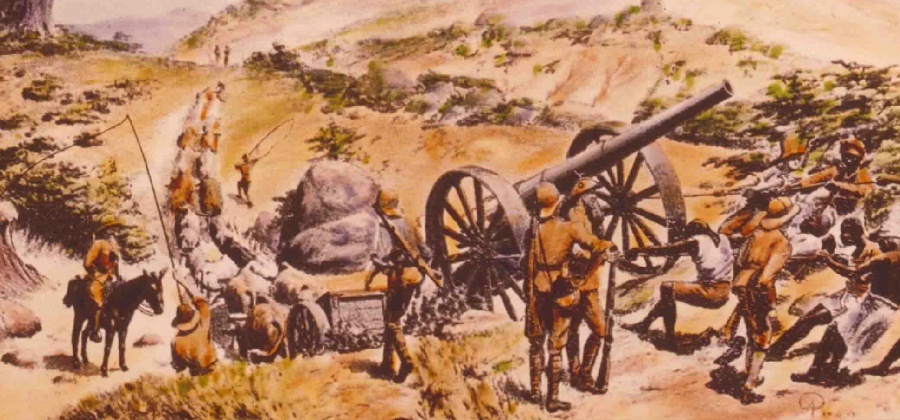
One of the Königsberg Guns being moved across East Africa
